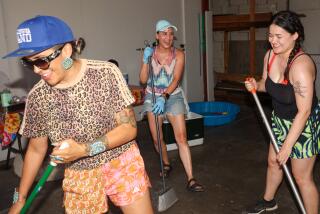Masonic Hall’s history quieter than the fraternity’s folklore
“The Lost Symbol,” author Dan Brown’s new, violent thriller, involves some strange findings at a Masonic temple near the White House. (Wine-filled skull and severed hand, anyone?)
Brown capitalizes on the Masons’ reputation as a secretive fraternal and charitable movement that has been accused by conspiracy theorists of just about everything, including plotting with extraterrestrials to take over the world.
Standing in quiet contrast to such drama is Los Angeles’ 151-year-old Masonic Hall.
The empty building, now part of the El Pueblo de Los Angeles Historical Monument south of Olvera Street, has been shuttered for rehab for several years.
Of course, the Masons of Lodge 42 in L.A. have had some adventures, starting with an 1854 shooting that involved a member with the rank of Worshipful Master.
Hilliard Dorsey, described by historian Harris Newmark as a “typical Western character” with a “fiery temper,” developed non-fraternal feelings for another Mason and fought a duel with him.
Each “suffered a severe wound,” according to temple records. The Worshipful Master and his enemy were both expelled from the group.
It was in 1858 that the organization moved into what became known as the Masonic Hall building -- its first permanent headquarters -- at 416 N. Main St. The Masons paid $20 per month to rent the second floor of the brick structure, which boasted a balcony with ornate ironwork railings.
“That so small a building was a hall, then considered a spacious meeting place, is proof of the small scale of everything in those days,” The Times’ Timothy Turner observed in 1936.
The building’s owners ran a carpentry and furniture-making business on the first floor. (Conspiracy buffs -- or Dan Brown, at least -- might find it interesting that the owners built caskets.)
Early Masons included several notable citizens: Benjamin Wilson, the grandfather of World War II hero George S. Patton Jr.; and Alpheus Hodges, the city’s first elected mayor.
As renters, the Masons complained about a few building issues, including the lack of interior lighting, an El Pueblo history recounted.
A lone chandelier in the room was referred to as the “traveling chandelier” because it was constantly being borrowed by churches, businesses and individuals. The Masons also lamented the poor ventilation, despite at least five windows and four doors opening into the hall.
“Perhaps the privacy sought by the Lodge membership . . . prohibited effective use of these openings,” the El Pueblo history tactfully observed.
In 1868, the disenchanted Masons moved to a location several blocks away. Thus began a new chapter for the Masonic Hall that was left behind.
During the boom years of the mid-1880s, the building was used by several real estate firms as well as a man named H.L. Flash, who listed himself as a “capitalist.”
In later years, as businesses moved south of Temple Street and the Plaza area declined, the landmark was inhabited by more modest businesses, such as bars, rooming houses, pawn shops and, unofficially, of course, brothels.
Times writer Turner recalled when the building was an earthy boarding house in the 1920s. The “proprietress,” he wrote, “kept canaries and an impudent parrot which she put out on the balcony in appropriate weather as she sat in the doorway and combed her hair or peeled potatoes, as occasion required.”
When Turner visited in 1936, he wrote that “as one passes this old building, two inharmonious smells assail the nose. One is emitted from the barber shop, which occupies half of the street level, a smell of many perfumes and lotions. . . . The smell from the opposite half is of chili pepper, coffee and frijoles being fried with cheeses, for it is a mart of victuals.”
The building was also occupied by a sign painter “who puts roses, if urged, on his signs, and who has the soul if not the technique of a Great Master,” Turner wrote.
By the late 1940s, the Masonic Hall was ticketed for destruction to make way for the 101 Freeway. But the Masons lobbied successfully to save it from being sideswiped by the 101 and it was acquired by El Pueblo, a victory for the new historic preservation movement.
Lodge 42, which now meets in Santa Monica, rededicated the landmark as a museum and filled it with memorabilia until it was declared seismically unsafe several years ago. The recession has slowed efforts to bring it up to code.
In the meantime, the beautifully restored exterior has been used as the fictional California Bureau of Investigation in episodes of “The Mentalist,” a TV show about paranormal powers. Something else for conspiracy theorists to ponder?
Whatever, there is nothing mysterious about the vacant structure itself, except perhaps for one door that bears a Masonic symbol: a compass overlapping a square, with a “G” (for God) in the middle.
Oddly enough, it looks as though someone tried to rub out part of the symbol, as though to keep it a secret. Or maybe the damage was just the work of an impudent parrot.


